Related Research Articles

The siege of Sarajevo – the capital of Bosnia and Herzegovina – was the longest siege of a capital city in the history of modern warfare. After being initially besieged by the forces of the Yugoslav People's Army, Sarajevo was besieged by the Army of Republika Srpska from 5 April 1992 to 29 February 1996 during the Bosnian War. The siege lasted three times longer than the Battle of Stalingrad and more than a year longer than the siege of Leningrad.
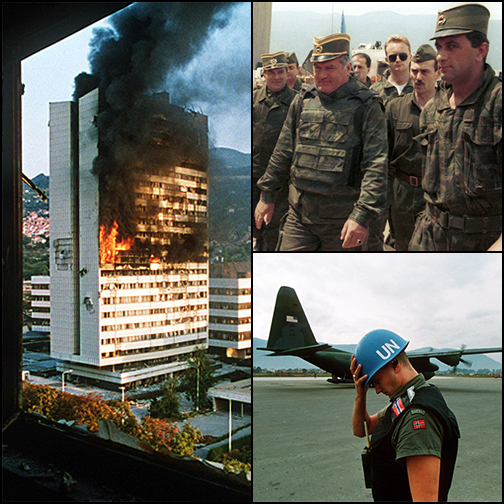
The Bosnian War was an international armed conflict that took place in Bosnia and Herzegovina between 1992 and 1995. The war is commonly seen as having started on April 6, 1992, following a number of earlier violent incidents. The war ended on December 14, 1995. The main belligerents were the forces of the Republic of Bosnia and Herzegovina and those of Herzeg-Bosnia and Republika Srpska, proto-states led and supplied by Croatia and Serbia, respectively.

Novi Grad is a municipality of the city of Sarajevo, Bosnia and Herzegovina. It is the westernmost of the four municipalities that make up the city of Sarajevo.

The Srebrenica massacre, also known as the Srebrenica genocide, was the July 1995 genocide of more than 8,000 Bosniak Muslim men and boys in and around the town of Srebrenica, during the Bosnian War.

The United Nations Protection Force, was the first United Nations peacekeeping force in Croatia and in Bosnia and Herzegovina during the Yugoslav Wars. The force was formed in February 1992 and its mandate ended in March 1995, with the peacekeeping mission restructuring into three other forces.

Operation Deliberate Force was a sustained air campaign conducted by the North Atlantic Treaty Organisation (NATO), in concert with the United Nations Protection Force (UNPROFOR) ground operations, to undermine the military capability of the Army of Republika Srpska (VRS), which had threatened and attacked UN-designated "safe areas" in Bosnia and Herzegovina during the Bosnian War with the Srebrenica and Markale massacres, precipitating the intervention. The shelling of the Sarajevo market place on 28 August 1995 by the VRS is considered to be the immediate instigating factor behind NATO's decision to launch the operation.
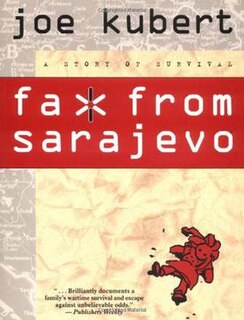
Fax from Sarajevo: A Story of Survival is a nonfiction graphic novel by veteran American comic book artist Joe Kubert, published in 1996 by Dark Horse Comics.

The Markale market shelling or Markale massacres were two separate bombardments, with at least one of them confirmed to have been carried out by the Army of Republika Srpska, targeting civilians during the siege of Sarajevo in the Bosnian War. They occurred at the Markale (marketplace) located in the historic core of Sarajevo, the capital of Bosnia and Herzegovina.
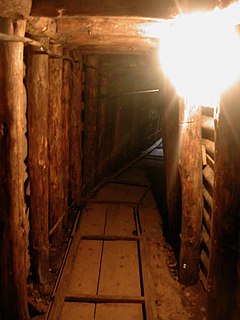
The Sarajevo Tunnel, also known as Tunel spasa and Tunnel of Hope, was a tunnel constructed between March and June 1993 during the Siege of Sarajevo in the midst of the Bosnian War. It was built by the Bosnian Army in order to link the city of Sarajevo, which was entirely cut off by Serbian forces, with Bosnian-held territory on the other side of the Sarajevo Airport, an area controlled by the United Nations.
Hakija Turajlić was a Bosnian politician, economist and businessman who served as the first Deputy Prime Minister of the Republic of Bosnia and Herzegovina from 15 June 1992 until he was killed on 8 January 1993.

The Siege of Srebrenica was a three-year siege of the town of Srebrenica in eastern Bosnia and Herzegovina which lasted from April 1992 to July 1995 during the Bosnian War. Initially assaulted by the Yugoslav People's Army (JNA) and the Serbian Volunteer Guard (SDG), the town was encircled by the Army of Republika Srpska (VRS) in May 1992, starting a brutal siege which was to last for the majority of the Bosnian War. In June 1995, the commander of the Army of the Republic of Bosnia and Herzegovina (ARBiH) in the enclave, Naser Orić, left Srebrenica and fled to the town of Tuzla. He was subsequently replaced by his deputy, Major Ramiz Bećirović.
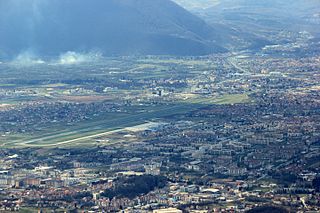
Dobrinja is a neighbourhood in the western outskirts of Sarajevo, part of the municipality of Novi Grad. It is estimated to have a population of 40,000 inhabitants. Its name comes from the short river Dobrinja that flows through it. It is today organised in four local communities. Dobrinja lies just north of Sarajevo International Airport.

On 12 April 1993, the Army of Republika Srpska (VRS) launched an artillery attack against the town of Srebrenica, in eastern Bosnia, which left 56 dead and 73 seriously wounded, among whom were 14 children dead in a school playground. The attack came following the suspension of cease-fire talks, hours before NATO would implement a no-fly zone according to an UN resolution. VRS officials had previously told UNHCR representatives that the VRS would shell the town within two days unless it surrendered.

The Kravica attack was an attack on the Bosnian Serb village of Kravica by the Army of the Republic of Bosnia and Herzegovina (ARBiH) from the Srebrenica enclave on Orthodox Christmas Day, 7 January 1993. During the Bosnian War, the Srebrenica enclave was besieged by the Serb forces who rarely allowed humanitarian aid to enter the area, creating hunger and lack of medicine among the Srebrenica inhabitants. It is alleged that the ARBiH attacked, among other objectives, in order to find food, but also to acquire weapons, ammunition and military equipment. The attack was organized to coincide with the Serbian Orthodox Christmas, leaving the Serbs unprepared for any attack.

The Kravica massacre was one of the mass executions of Bosniaks by the Army of Republika Srpska during the Srebrenica massacre. It was committed on 14 July, 1995. It is estimated that between 1,000 and 1,500 men were killed.
Operation Irma was the name applied to a series of airlifts of injured civilians from Bosnia and Herzegovina during the siege of Sarajevo. The airlifts were initiated after the wounding of five-year-old Irma Hadžimuratović attracted international media attention. The programme was reported to have evacuated hundreds of Sarajevans during the second half 1993, but attracted significant controversy concerning its scale, evacuee selection criteria, and the motivations of the western European governments and press that inspired it.

The Siege of Bihać was a three-year-long siege of the northwestern Bosnian town of Bihać by the Army of the Republika Srpska, the Army of the Republic of Serbian Krajina and Bosniak dissenters led by the Bosniak politician Fikret Abdić during the 1992–95 Bosnian War. The siege lasted for three years, from June 1992 until 4–5 August 1995, when Operation Storm ended it after the Croatian Army (HV) overran the rebel Serbs in Croatia and northwest of the besieged town.

Želimir "Keli" Vidović was a Bosnian footballer and a star member of FK Sarajevo during the 1970s and early 1980s. He was killed during the Siege of Sarajevo while transporting wounded citizens of Dobrinja to a nearby hospital.
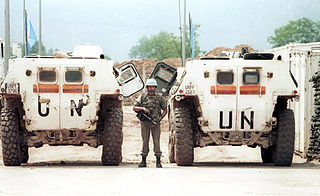
The Battle of Vrbanja Bridge was an armed confrontation which occurred on 27 May 1995, between United Nations (UN) peacekeepers from the French Army and elements of the Bosnian Serb Army of Republika Srpska (VRS). The fighting occurred at the Vrbanja Bridge crossing of the Miljacka river in Sarajevo, Bosnia and Herzegovina, during the Bosnian War. The VRS seized the French-manned United Nations Protection Force (UNPROFOR) observation posts on both ends of the bridge, taking twelve French peacekeepers hostage. Ten were taken away, but two were kept at the bridge as human shields.
Around 2:30 p.m. on Sunday, 1 March 1992, a Bosnian Serb wedding procession in Sarajevo's old Muslim quarter of Baščaršija was attacked, resulting in the death of the father of the groom, Nikola Gardović, and the wounding of a Serbian Orthodox priest. The attack took place on the last day of a controversial referendum on Bosnia and Herzegovina's independence from Yugoslavia, in the early stages of the breakup of Yugoslavia and the Yugoslav Wars.
References
- 1 2 3 4 United Nations (28 December 1994). "Incident study report regarding mortar shelling Dobrinja, Sarajevo". Archived from the original on 26 October 2010. Retrieved 3 February 2010.
- 1 2 3 Kurt Schork (2 June 1993). "Blood and tears end a soccer game which no one could win". London: The Guardian (UK). Retrieved 3 February 2010.
- ↑ Connie Chung (1 June 1993). The CBS Evening News with Dan Rather and Connie Chung.(6:39: "Today was a holiday for the Muslims of Bosnia, and some young people decided to ignore the war and choose up sides for a ball game. It wasn't long before their soccer field was soaked in blood. As David Martin reports, it was a grim reminder of the world's failure to end the slaughter in Bosnia.")
- ↑ "On this day: 1993: Serb attack on football match kills 11". BBC News. 1 June 1993. Retrieved 3 February 2010.
- ↑ Tony Smith (6 February 1994). "Shelling of Sarajevo Market Kills 66; More Than 200 Wounded". The Washington Post. Associated Press. Retrieved 3 February 2010.
- ↑ Chuck Sudetic (2 June 1993). "MORTAR FIRE KILLS 12 AT SOCCER GAME IN BOSNIAN CAPITAL". The New York Times. Retrieved 3 February 2010.